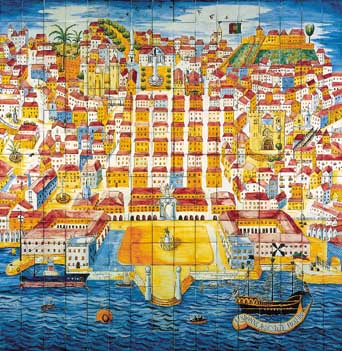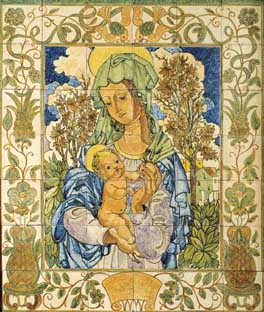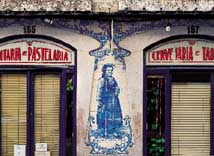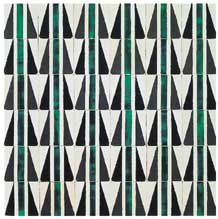|
|
|
|
|
|
|
|
|
|
|
|
|
|
|
|
|
 |
|
|
|
|
|
|
|
|
|
|
|
 |
|
|
|
|
|
|
|
|
|
The XX Century
From Rafael Bordalo Pinheiro
to Jorge Barradas
|
 he taste for eclectic Revivalism and tile façades was to extend into the first three decades of the XX century. he taste for eclectic Revivalism and tile façades was to extend into the first three decades of the XX century.
Rafael Bordalo Pinheiro (1847-1905) experimented with the production of "Artistic Ceramics" at the Caldas da Rainha Faience Factory, where he also made Art Nouveau tiles.
The panel entitled ?Lisbonne aux Mille Couleurs" (Lisbon of a Thousand Colours) by the painter Paolo Ferreira (1911-1999) was shown at the Portuguese Pavilion at the 1937 Paris International Exposition. It was displayed integrated within modern architecture, and reflected an openly modernist style.
However, it was Jorge Barradas (1894-1971) who was to be responsible for the great revival of Artistic Ceramics in Portugal and their transformation into a modern art form applicable to the architecture of the second half of the XX century.
He began his work - which was primarily centred on figurative stylisation and a sophisticated search for ceramic effects - in 1945 in the Viúva Lamego Factory, where he was to become a Master of Ceramics teaching a series of young artists whose talent revealed itself in the post-war years.
|
|
|
|
|
«Lisbonne aux mille couleurs»,
Paolo Ferreira, 1937, MNA inv. 5928.
photograph: José Pessoa (DDF-IPM)
|
|
|
|
|
|
|
|
|
|
|
|
|
|
|
 |
|
|
|
|
|
|
 |
|
|
|
|
|
|
|
|
Façade of the "A Camponesa" Dairy,
Lisbon,
José António Jorge Pinto, 1908.
|
|
|
|
|
|
|
|
 |
|
|
|
|
|
|
|
|
|
|
|
Our Lady with the Christ-Child,
Jorge Barradas, mid XX century,
The City Museum, Lisbon.
photograph: Paulo Cintra and Laura Castro Caldas
|
|
|
|
|
|
|
|
|
|
|
 |
|
|
|
|
|
Relief tiles with grasshoppers,
Rafael Bordalo Pinheiro,
c. 1905, MNA cat. 185.
photograph: José Pessoa (DDF-IPM)
|
|
|
|
|
|
|
|
|
|
Azulejo Panel, Raúl Lino,
Casa do Cipreste, Sintra, c. 1915,
MNA cat. 175.
|
|
|
|
|
|
|
|
|
|
|
© Instituto Camões, 2000
|
|
|
|
|